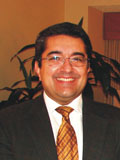Visiting Researchers
 |
Institute |
Geophysikalisches Institut, Universitat Karlsruhe |
Title |
Senior Research Fellow | |
Country |
Germany | |
Period of Stay |
2008/11/09 - 2008/12/06 | |
Research Theme |
Quantitative modeling of geodynamic evolution of Japan and its surroundings | |
Host Researcher |
Satoru HONDA |
When I was a schoolboy, my father, a geophysicst, liked to invite his colleagues at home and to discuss Earth-related problems during a dinner or supper till late night. Sometimes their discussions were tiresome to me. I liked math very much and told myself: “no geophysics, yes math” … That was the way of how I came in science of the Earth … Now I work in Karlsruhe, Moscow, Paris and Trieste and cooperate with geoscientists around the world. I tell my students and colleagues: “geophysics is not boring at all, it is an exciting riddle, and we should try to find a quantitative approach to resolve at least some of its challenging problems”.
I have visited ERI two times and am very happy to be back here again. What do I do in science? A principal objective of my research is to understand interplay between crustal/mantle dynamics and surface processes by means of theoretical and experimental studies. My approach is three-pronged: (i) to study geophysical phenomena on the basis of available observations; (ii) to develop mathematical and numerical methodologies and to apply them to model dynamical processes in the crust and mantle; and (iii) to test model predictions against observations explaining specific features of the processes and phenomena. At present my basic research interests are concentrated on data assimilation (inverse problems) in geodynamics; studies of sedimentary basin evolution including salt tectonics; and in earthquake modeling including seismic risk assessment. Why does the problems interest me? As a geophysicist, I interest the problems to understand a complex dynamic behavior of the crust, lithosphere, and mantle. As an applied mathematician, I interest them to bring formalism to Earth sciences. And as a habitant of our planet, I interest them to know how to cope with depletion of natural resources and natural disasters.
While visiting ERI I am collaborating with Prof. Satoru Honda on numerical reconstructions of Pacific plate subduction beneath the Japanese islands back to the Miocene times. I would like to learn more about geological history of the area, to interact with local geophysicists, particularly with seismologists, and to set up new projects with Japanese colleagues.
During my stay at ERI from 10 November to 5 December 2008, I collaborated with Professor Satoru Honda on numerical modeling of the Pacific plate subduction and the evolution of the Japan Sea. I used a newly developed technique of data assimilation (quasi-reversibility method) to reconstruct the Pacific plate subduction back to the Early Miocene times.
Mantle heterogeneities imaged by seismic tomography beneath the Japanese islands contain information on the present thermal state of the mantle. Based on P-wave seismic velocity anomalies we developed a model of the present mantle temperature beneath the region and combine the model with a model of crustal temperature constrained by heat flow data. The seismic temperatures were assimilated to the Miocene times using an inverse mantle convection model and the information on geodetic measurements and the knowledge on the paleo-movements in the region. Thermal states of the lithospheric slab descending in the region are restored, and temperature and flow patterns are determined in the geological past. The quantitative results provide insight on the geodynamic conditions at the time of the Japan Sea opening.
The results of the research were discussed at seminars of ERI and the Department of Earth and Planetary Sciences of the University of Tokyo and presented at the session “Structure of the Earth” of the Asian Seismological Commission General Assembly. Manuscripts based on the research results are under preparation.
I am very thankful to Prof. S. Honda for very fruitful collaboration and his hospitality. I am grateful to Profs. S. Okubo and T. Kato for inviting me to ERI of the University of Tokyo, and to Mrs. T. Watanabe for her assistance before my travel and during my stay in ERI.
